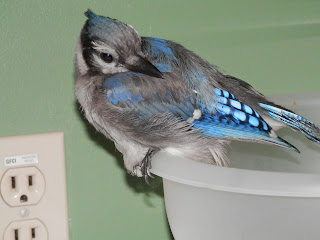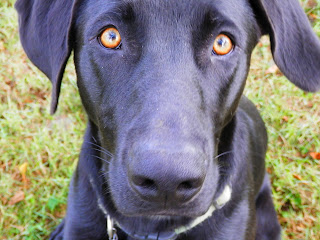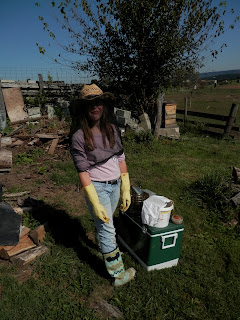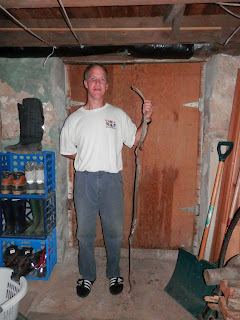Lucky, the Blue Jay, continues to thrive and grow. We think it's a female. Apparently the only way to tell males and females apart on these birds is if there's a patch of feathers missing on the breast. This is an incubation patch that only the females have but it's very difficult to see unless the bird is wet or you hold her upside down and look closely. Lucky does not like being held upside down but if you look at the photo below you can see a hint of this incubation patch.
This picture, by the way, was taken while she was wet because she had just jumped into my mug of coffee!
The major drawback to living with a bird is the mess. Oh, the mess!
We keep Lucky's feeding area and the windowsills covered with towels but as she's gotten older she's less and less content to spend her day sitting in the window. She's constantly on the move.
She stays busy all day long; hopping around the floor, flying all over the house and hunting for food or treasures. Blue Jays, like other birds, eat small amounts of food but feed constantly. These birds also like to stash food for later. While we were researching Blue Jays, we found out they're the number two planter of oak trees. They eat acorns but also hide them like squirrels. Lacking acorns, Lucky hides her food all over our house. In this photo she's shoving a half-dried worm into my computer bag.
When I opened the bag to retrieve the worm, I found a dried pea she'd hidden earlier. She likes to shove peas and dried bugs between our toes. That's an interesting feeling, believe me!
Once, after we'd eaten some watermelon, she flew up to the counter and began to peck at the rind. Suddenly she jumped into the watermelon and began flapping around and rubbing her head in the juice. We were laughing and wondering what on earth she was doing when it suddenly dawned on us that she was trying to take a bath. Now we line the sink with a towel and run water for her.
Here she's wet from a bath.
While she dries she likes to sit in the sun and fluff her feathers. She's starting to turn more and more blue instead of gray.
She has this strange fascination with the napkins. We've had to put them inside a cabinet because she just won't leave them alone. She pulls them out of the napkin holder . . .
And flings them onto the floor.
If she gets hold of one, she'll take off flying with a napkin trailing behind her. We have to chase her down and grab it out of her beak before she rips it apart and eats it. She seems to know, though, our intent when we're trying to take a treasure from her. She's fast! She'll dive in and grab a bit of food and then take off in a flash. The other morning she stole the last bit of DS's bagel, complete with cream cheese on top, and tried to fly off with it. The weight kept her from getting too far but we let her have it. Who wants to eat a bagel after the bird has scrubbed it on the floor?

She's not shy about eating directly from our plates. She especially likes cooked egg but she likes them best warm right from the microwave. When we pull the bowl out we have to keep it covered otherwise she'll swoop in and steal a bite. My mom is visiting this week. The other morning I came downstairs and opened the door to the pantry - there was my mom, eating her breakfast in the pantry to keep the Blue Jay out of her oatmeal!
It's been a great adventure having Lucky with us but we're hoping she'll soon live a more normal Blue Jay life outside. We've explained to her there won't be anyone around to microwave an egg for her so she'd better get used to a diet of bugs and worms, but so far she's not keen on the idea. She's spent three nights outside like a real bird and she'll sometimes spend a large part of her day outside but when she's ready for a snack or she wants to settle in for the night, she flies back to the dining room windowsill and waits until we let her back in.
This morning as DH was walking out the door for work he asked us to check him over for bird poo because Lucky had just landed on his shoulder. My mom's still laughing about that. She says we're the only family she knows who has to check each other for Blue Jay presents before leaving the house. It's always an adventure here!




















































